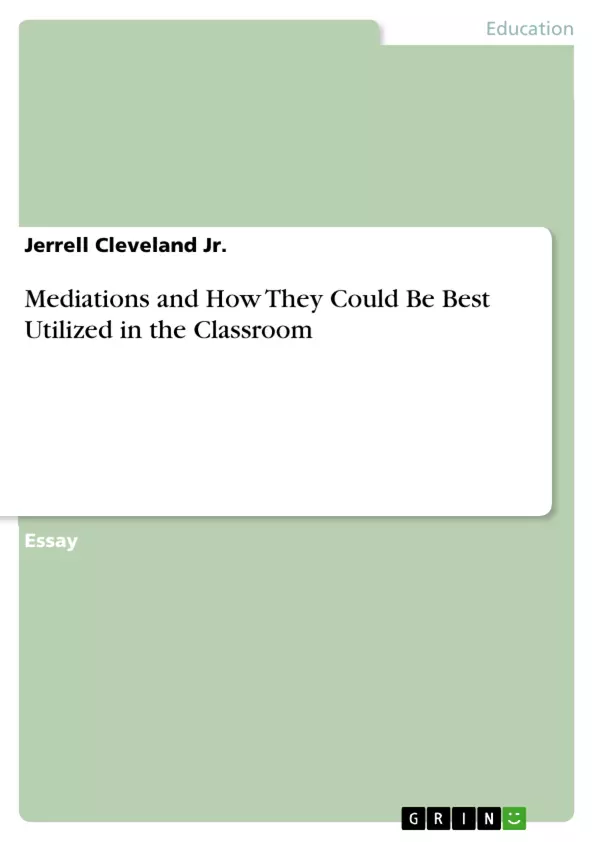This paper will attempt to explain to you nine different mediations, why they are important and examples of how they can be utilized in the classroom. Those mediations that will be discussed are as follows: 1) Mediation of Intentionality and Reciprocity; 2) Mediation of Meaning; 3) Mediation of Transcendence; 4) Mediation of Competence (TESA Strategies); 5) Mediation of Sharing Behavior; 6) Mediation of Individuation; 7) Mediation of Goal Planning; 8) Mediation of Challenge; and 9) The Mediation of Self-Change. We will begin this discussion with the Mediation of Intentionality and Reciprocity. The first thing we have to do during this particular mediation is to begin sharing the mediators (teacher’s) intentions with his or her student and or mentee. Sharing our intentions allows the student and or mentee that we are a team in this process, in which we will both gain knowledge and develop from. Sharing also important because it allows us an opportunity to be sure that our students and or mentees have a full understanding of what is required and expected of them during this process (Vigoya & Stella, 2005). The biggest goal here is to be sure that the mediator is challenging his learners with realistic learning experiences and academic task using a wide variety of authentic situations and experiences, in which the learners can relate to.
Inhaltsverzeichnis (Table of Contents)
- Mediation of Intentionality and Reciprocity
- Mediation of Meaning
- Mediation of Transcendence
- Mediation of Competence (TESA Strategies)
- Mediation of Sharing Behavior
- Mediation of Individuation
- Mediation of Goal Planning
- Mediation of Challenge
- The Mediation of Self-Change
Zielsetzung und Themenschwerpunkte (Objectives and Key Themes)
This paper explores nine different mediations and their potential implementation in the classroom. The author aims to provide an understanding of these mediations and their significance in fostering student learning.- Developing a collaborative learning environment through shared intentionality and reciprocity.
- Integrating meaning into learning experiences by considering students' social, cultural, and economic backgrounds.
- Enhancing the applicability of knowledge and skills beyond the classroom through the mediation of transcendence.
- Boosting student confidence and competence by providing positive feedback and recognizing accomplishments.
- Fostering analytical thinking and behavioral regulation through the mediation of behavior sharing.
Zusammenfassung der Kapitel (Chapter Summaries)
- Mediation of Intentionality and Reciprocity: This mediation emphasizes the importance of building a collaborative learning environment by sharing the teacher's intentions with students and establishing a shared understanding of goals and expectations. The text emphasizes the need to consider students' diverse backgrounds, learning styles, and potential challenges to create relevant and engaging learning experiences.
- Mediation of Meaning: This mediation delves into the connection between meaning-making and social, cultural, and economic factors influencing students' experiences. The author argues that understanding these factors is crucial for creating lessons that resonate with students and facilitate meaningful learning.
- Mediation of Transcendence: This mediation focuses on applying learned knowledge and skills to real-life situations beyond the classroom. The author suggests utilizing strategies like scenario-based learning and guest speakers to demonstrate the relevance of classroom learning to students' future lives.
- Mediation of Competence (TESA Strategies): This mediation emphasizes the importance of providing positive feedback and encouragement to foster students' confidence and belief in their abilities. The text highlights the significance of recognizing accomplishments and offering constructive guidance even in cases of incorrect responses.
- Mediation of Behavior Sharing: This mediation examines the process of regulating students' behavior through pre-task planning, monitoring, and analysis. The author underscores the importance of developing analytical thinking skills and promoting self-awareness to manage impulsive reactions and engage thoughtfully with various situations.
Schlüsselwörter (Keywords)
This paper focuses on the theoretical framework of mediations, particularly their application in education. Key concepts include intentionality, reciprocity, meaning-making, transcendence, competence, behavior sharing, goal planning, and self-change. The text examines how these mediations can be effectively implemented in the classroom to enhance student learning and development.- Citation du texte
- Jerrell Cleveland Jr. (Auteur), 2015, Mediations and How They Could Be Best Utilized in the Classroom, Munich, GRIN Verlag, https://www.grin.com/document/294061



